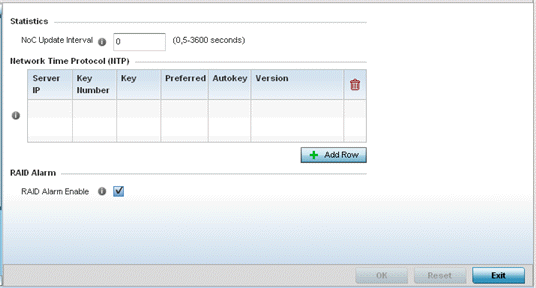To review a profile‘s original configuration requirements and the options available for a target device, refer to General Profile Configuration.
To define a device‘s general profile override configuration:
The Device Configuration screen displays a list of managed devices or peer controllers. The listed devices can be other controllers or access points.
Devices can also be selected directly from the Device Browser in the lower, left-hand side of the UI.


Note
A blue override icon (to the left of a parameter) defines the parameter as having an override applied. To remove an override go to the Basic Configuration section of the device and click the Clear Overrides button. This removes all overrides from the device.| Server IP | Set the IP address of each server as a potential NTP resource. |
| Key Number | Select the number of the associated Authentication Key for the NTP resource. |
| Key | If an autokey is not being used, manually enter a 64 character maximum key the controller or service platform and NTP resource share to securely interoperate. |
| Prefered | Select the radio button to designate this particular NTP resource as preferred. If using multiple NTP resources, preferred resources are given first opportunity to connect to the controller and provide NTP calibration. |
| AutoKey | Select the radio button to enable an Autokey configuration for the controller and NTP resource. The default setting is disabled. |
| Version | Use the spinner control to specify the version number used by this NTP server resource. The default setting is 0. |
RAID controller drive arrays are available within NX 9000 series service platforms (NX 9000, NX 9500 and NX 9510 models) only. However, they can be administrated on behalf of a NX 9000 profile by a different model service platform or controller.
NX 9000 series service platforms include a single Intel MegaRAID controller (virtual drive) with RAID-1 mirroring support enabled. The online virtual drive supports up to two physical drives that could require hot spare substitution if a drive were to fail. With the WiNG 5.5 release, an administrator can manage the RAID controller event alarm and syslogs supporting the array hardware from the service platform user interface and is not required to reboot the service platform BIOS.